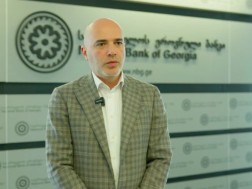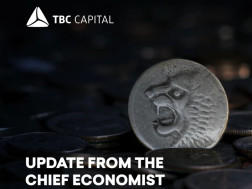TBC Capital published Update From The Chief Economist. TBC Capital predicts a reduction of the refinancing rate to 8% late this year.
According to the document, the NBG monetary policy meeting scheduled on March 13 is in the spotlight this week. The central bank remained hawkish throughout the post-pandemic period, maintaining the refinancing rate at 11.0% for more than a year. As inflation pressures have cooled down and economic activity started to normalize, the regulator has gradually eased its stance. The NBG became more noticeably dovish recently, delivering two 50-basis point cuts in December and January, cutting the MPR to 9.0%. The dovish narrative was also noticeable in the latest monetary policy guidelines. In this regard, our latest projection for the end of 2024 stood at around 8.25%, though TBC Capital says there may be more dovish stance than anticipated and furthermore, sooner throughout the year. The latest update on so called GEL rate drivers looks as follows.
"As already discussed in the monthly update last week, despite the historical data revision which led to the upside in growth outlook, normalization of economic activity is a baseline. In addition, moderated real GDP growth in January was followed by lower than expected inflation print in February, standing at 0.3% YoY and more importantly at -0.3% MoM in seasonally adjusted terms. Despite some upward pressures in monthly domestic and service indices, these underlying inflation measures still remained close to the NBG 3% target. Also, respective trimmed measures, useful for excluding possible one-offs from analysis, remained low. Speaking of temporary factors, we should once again note the initiated export restriction on Russian gasoline with the impact on price dynamics being estimated to be limited to around 0.3 pp and only temporary throughout the year. Combined with lower than anticipated inflation figures recently, we stick to our previous projection of 4.1% at the end of the year, assuming Brent prices at around 79 USD and the GEL exchange rate projection unchanged from our latest stance.
As a result, both growth and inflation outlooks are rate cut supportive keeping in mind, that 2024 year-end slight overshooting is mainly due to the base effect, rather than building above-target inflation pressures as such. This appears to hold even taking into account elevated unit labor costs as the normalization trend is evident. Furthermore, we stick to our view that wages are also and likely even to more extent determined by the inflation, rather than the economic growth only, though with current outlook for both pointing to the normalization.
Although recent adjustments to historical productivity trends suggest a less severe overvaluation of the GEL exchange rate, it remains somewhat overvalued compared to its long-term estimated equilibrium, allowing to argue that a rather very moderate but still an adjustment is not something to be ruled out. Though here we once again note high passthrough from the GEL to inflation, another reason for the limited shifts as such. Furthermore, normalized but still strong net inflows and the NBG recently having a rather larger space and in fact willingness for the interventions, notably with switching back to the buying side recently, is also seen as a rate cut supportive.
After a period of the rather moderate credit growth when adjusted for inflation, the nominal GDP and the trend, 2023 has been a year of recovery. At the same time, moderation in January with FX and seasonally adjusted annualized MoM growth of only 7.4% was observed as well as some cooling down in annual terms. This might be temporary, but in any case, clearly there is no evidence of the credit growth being excessive and therefore no constraints here for the continuation of the easing cycle.
First of all, we note that even more dovish stance still implies the GEL rate to stand above the so called neutral one, around 7.5% or slightly lower based on our estimates. However, that also implies the Fed and the ECB rates to stand around estimated respective neutral levels as well. Not to jump into an academic discussion on the neutral rates and keep it rather simple, for sure the recent stance in US as well as in the Euro Area is tight. Therefore, while, based on the Georgian macro, there can be a case of reaching the GEL neutral rate even at once, we say, until the USD and Euro rates are elevated, that’s hardly possible. At the same time, holding of Georgian treasury securities by non-residents remains flat, while country’s risk premium, measured as Georgia’s sovereign USD Eurobond interest rate spread over US 10 Year treasury yield, though recently increasing marginally, appears to have dropped substantially after receiving the EU candidate status.
Summing up, we say the MPR should stand around 8% by the end of the year, instead of around 8.25 deemed earlier", - the document reads.
















